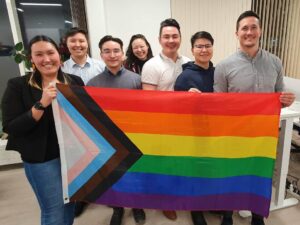Greenlandic is a language which is rich in cultural heritage, and it is currently evolving to be more inclusive by developing words and terms for the 2SLGBTQIA+ community. This is a big step, enabling all queer Inuits in Greenland to express themselves in their native language.
Last year, Sipineq+ (a volunteer association for the 2SLGBTQIA+ community in Greenland) started this important work. They teamed up with three volunteer translators to create a list of 132 words and terms which cover the wide range of identities and experiences in the 2SLGBTQIA+ spectrum. They collaborated continuously and discussed their suggestions on what these terms could be in Greenlandic and they explained the meaning to our volunteer translators. This helped the translators to develop better suggestions for Greenlandic terms, and allowed them to gather input from the members and related partners. After 9 months, they had finished their suggestions, and the list was sent to the Language Secretary of Greenland for review.
The Language Board of Greenland approved the first 10 of these terms at the beginning of the year. This means people can start using them in everyday conversations, making it easier to talk about identity, relationships, and experiences in their own language.
| Asexual | Atoqateqarusussuseqanngitsoq |
| Bisexual | Suiaqatiminoorlunilu suiaqatiginngisaminoortoq |
| Cisgender | Inunnguutsiminik suiaassutsimisut kinaassusilik |
| Gender-bending | Suiaassutsimik saqitsineq |
| Heterosexual | Suiaqatiginngisaminoortoq |
| Homosexual | Suiaqatiminoortoq |
| Intersex | Inunnguutsiminik suiaassusersiuminaatsoq |
| Non-binary | Suiaassutsinut pituttorsimanngitsoq |
| Pansexual | Tamanoortoq |
| Transgender | Inunnguuserinngisaminik suiaassusilik |
Encouraged by this progress, the Language Secretary and its team expanded the list up to 190 words and terms, marking another step towards strengthening diversity, safety, and inclusivity together with Sipineq+. Both parties collaborated and discussed the meaning of the words and how they correspond to the meaning in English in the most respectful and inclusive way possible. This extended list just got reviewed by the Language Board in June, where all the words have been accepted and is being adopted in the expanding Greenlandic dictionary which is hereby becoming more inclusive. Creating 2SLGBTQIA+ terminology in Greenlandic is more than just adding new words. It’s about making sure everyone feels seen and respected. By including these terms, Greenlandic becomes a better reflection of the people who speak it, helping to build a more inclusive society, and to have a common understanding of words in the areas of sexual orientation and gender identity. Within these areas there are terms that are not generally known and terms that are often used with different or incorrect meanings. This project shows how important language is in shaping our understanding of identity and community as Queer and Indigenous people in the arctic. The work and the Language Board’s approval of these terms is a significant achievement, showing the community’s commitment to inclusivity and growth.

Prior to European colonization, indigenous people inhabiting the Arctic were diverse and inclusive towards sexual orientation and gender identity. However, the colonial heteronormative systems and religious institutes challenged the societal, cultural, and structural aspects of Inuit beliefs. As a result of this, Inuit communities began adopting more rigid and stigmatizing views towards the 2SLGBTQIA+ community. Queer people in the Arctic are now actively challenging the very same systems that exclude their rights. They are breaking the silence and addressing the stereotypes and misconceptions that they perpetuated for too long.
For example, they are embracing their identities with the revitalization of Sipineq (which means ‘to split’). This is also what the voluntary association name is inspired by. This has been forgotten in Greenland. However, it is still used in Nunavut which is the closest indigenous relative to Inuit in Greenland. 2SLGBTQIA+ individuals are asserting their rights to be seen, heard, and valued within their communities, where they are fighting for a more inclusive society that recognizes and celebrates diverse sexual orientations and gender identities.
Furthermore, the legacy of colonialism and its impact on indigenous communities has created additional barriers. The imposition of western ideologies and systems has disrupted traditional structures that once embraced gender and sexual diversity. Decolonization efforts are essential in reclaiming and revitalizing indigenous knowledge, practices, and cultural expressions, providing a framework for empowering 2SLGBTQIA+ individuals.
Qillaq Ilannguaq Olsen is Inuk (indigenous), and he is born and raised in Qaanaaq, the northest city in Greenland. He works as a sustainability consultant, and he is the co-founder and Chairperson in Sipineq+, which is a 2SLGBTQIA+ volunteer association in Greenland with an Association Award in Danish Rainbow Awards in 2023.





